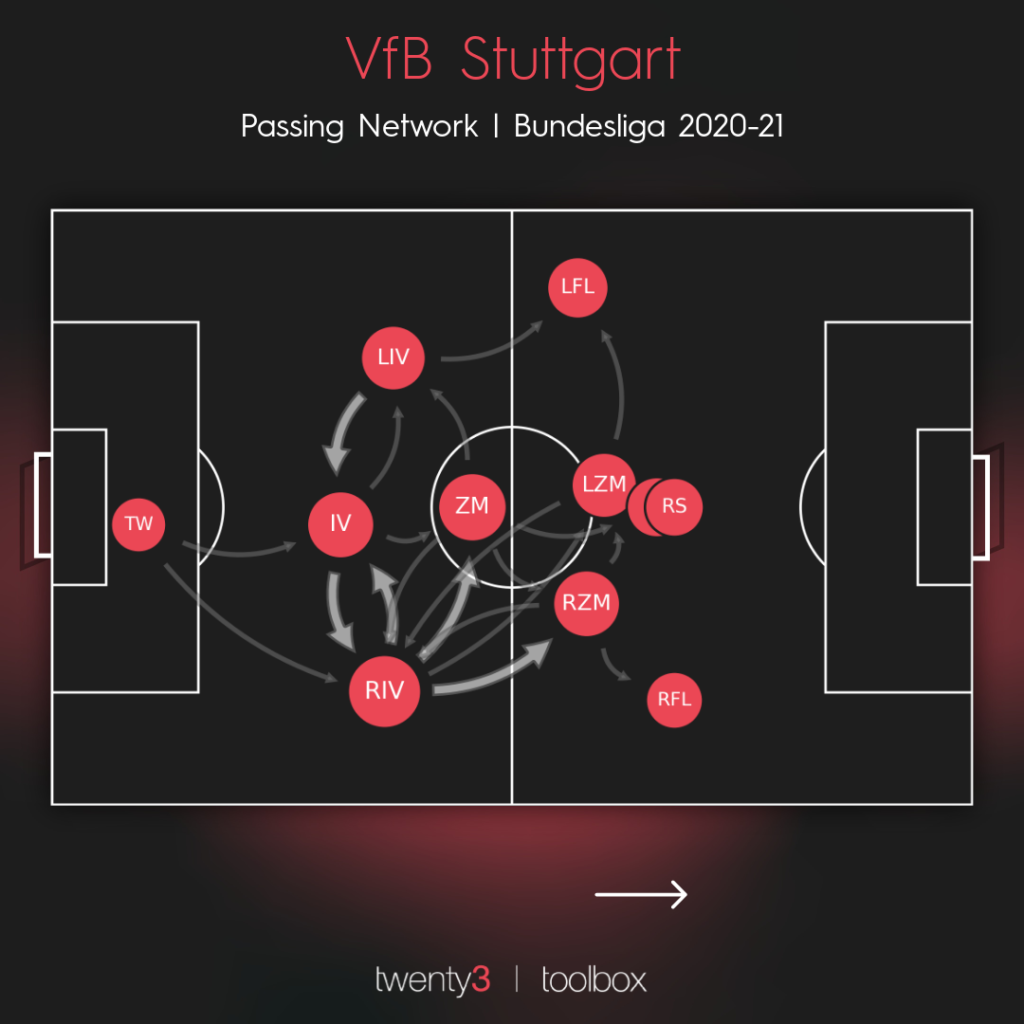
[ad_1]
VfB Stuttgart have outperformed expectations during the Hinrunde. Yet, perhaps more so than their results and play, the array of strategies and structures employed in build-up and defensive transitions have left an impression on the Bundesliga. Head coach Pellegrino Matarazzo has established a formidable attacking team that consistently penetrates and creates, and hence can beat almost every opponent.
As a result VfB are in the top 5 in every shooting metric from goals scored, xG for and xG difference, non-penalty xG per shot, to less advanced stats such as shots, shots on target. They have done this despite hitting the woodwork, a league high 12 times! Let’s take a look at how Stuttgart have achieved this feat:
The clear strength of the Swabians remains their ability to create flexible and effective structures across the pitch, allowing to pick up pace and a strong level of intensity. Such structures serve as the foundation for their strong play in ball possession. This also allows for strong counter-pressing in defensive transitions, i.e. after ball losses. The phase when opponents have the ball is strategically not focused as much as the other game phases. In fact, this phase of the game remains the largest source of errors that led to scoring chances and goals against.
One year ago, Matarazzo began his tenure as head coach at VfB. Together with sporting CEO Thomas Hitzlsperger and sporting director Sven Mislintat, Matarazzo focused to combine attractive football and developing young players. Remarkably, the responsible people at VfB have remained true to their set path even after promotion to the top flight. In June after the VfB secured promotion to First Bundesliga, I shed light on VfB’s approach under Matarazzo to dominate games. Back then, the build-up structure favourable for counter-pressing as well as the balance between value-creating passes and protecting ball-losses stood out.
The rationale of this article is to explore how the VfB under Matarazzo performed in the Bundesliga. In doing so, the guiding question is how Stuttgart has managed the transition from Second to First Bundesliga. How has the team developed and adapted to the new category of opponents? To explore how these characteristics played out, three aspects will be considered: the general structure and key characteristics of the playing style, plays and mechanisms in ball possession, and the role of pressing and counter-pressing against the ball.
Structures, key characteristics and critical players
A key aspect in Matarazzo’s strategy is, on a higher level, the balance between offense and defence. Given his general focus on an offensive and dynamic playing style, the coverage of own attacks and the prevention of opposition counter attacks plays a key role. That is why the Italian-American coach lays such great importance on structures. He is constantly striving to have his team position in structures that allow to create scoring opportunities in ball possession while preventing counter attacks in cases of ball losses.
Their flexible and rather unpredictable 3-2-4-1/ 3-4-2-1 /4-3-3 – formation allows Stuttgart to create an array of strategies to progress past the opposition, particularly within a congested central area. In ball-possession and build-up, Matarazzo favors a back-three with flexible options to create a back-four. Graph 1 outlines the structure of Stuttgart’s formation. As depicted, the entire structure and pass frequency is shifted to the right, reflecting Stuttgart’s predominant side for attacking. Besides the higher position of the right winger in comparison to his pendant on the left side, the players on the “10” (LZM, RZM or LCM, RCM ) tilt towards the right. The RIV (RCB), usually Stenzel, serves as frequent starting point to start attacks. In building up, the player positioned as ZM (CM) takes on an important role in Stuttgart’s system – a feature we will come back to further below.

The flexible nature of several roles makes the formation more vivid and situationally unpredictable, and hence harder to defend for opponents. For instance, the position of the left winger, often occupied by Sosa, reflects this emphasis on flexibility in Matarazzo’s system. As Sosa is predominantly responsible for occupying lower points of his responsible zone on the left wing, he makes forward runs from a deep position less often than his counterpart, the electric Silas Wamangituka, on the right – introducing the element of surprise. The principal advantage of sudden forward runs from a deep position is the speed the player can pick up in comparison to the static opponent.
The right winger, in contrast, assumes a much offensive-focused role higher up the pitch. The structures and specific players lined-up often vary as Matarazzo aligns his team’s game approach to the opponent without losing its key characteristics. One common element is the tendency to face the opponent with up to three players up front. The selection of the players depends on the characteristics Matarazzo wants to bring on the pitch. For instance, while Klimowicz brings more deep runs and hence verticality to Stuttgart’s plays, Kalajdzic enables greater presence and stature up front, utilizable for long-rang passes.
Silas usually occupies this position on the right wing. Whereas Matarazzo selected more central positions and deeper positions for Silas back in the Rückrunde in the Second Bundesliga, Silas now is positioned in higher and often wider zones. This has generally had a positive effect. In the last analysis, I outlined Silas as player who has his strength when having an open field of vision towards the opponent goal. In turn, he does not feel comfortable when he is positioned with his back to the goal. His recent positionings on the wing and – in contrast to Sosa on the left – in higher positions, accounts for this attribute. In addition, he has the profile to beat defenders consistently once he has picked up pace. Having mentioned Silas as example, much of Matarazzo’s work is focused on the concept and deliberate thinking how to adapt structures in order to bring the individual strengths of players to shine.
Following the considerations about Stuttgart’s structures and critical players, the players on the “10” in the left and right half spaces are often prepared to support the central forward (Kalajdzic, Klimowicz, Coulibaly or Gonzalez). They move into aggressive man-oriented pressing in specific moments, depending on the respective opponent and its formation. For example, against Borussia Dortmund the focus was set on attacking the opposition back-four with three players up front and support by the wingers Sosa and Silas.
In turn to this flexibility, one element that is common and serves as foundation of Stuttgart’s approach against nearly all opponents is the line-up in the centre. Clearly, Endo and Mangala are the key players that connect the structures between the play in possession and the one against the ball (see graph 2).
Endo as Transitioner and bodyguard
Especially, Endo is directly involved in multiple mechanisms to move the ball forward and defend against attacking opponents. As indicated in graphs 1 and 2, in build-up Endo is positioned centrally as anchor. Part of his job profile includes what Julian Weigl used to do under Thomas Tuchel at Borussia Dortmund. By positioning himself intelligently, Endo occupies the central space to attract and prevent opponents from attacking the first line too quickly. Once the opportunity arises, he steps out of the cover shadow, providing an option for his team mates to break free of pressure. What sets him apart is the timing for such moves, and hence how he integrates in supporting transitioning to higher zones. In the next section this article will illustrate specific collective mechanism Endo is involved in.
Besides the importance for the play in ball possession, this central axis is also key in Matarazzo’s idea of coverage. Winning the ball 11.6 (4.6) times through ball steals (interceptions) on average per game, Endo is regarded as ‘bodyguard’ by sporting director Sven Mislintat. Both Endo and Mangala can be considered as supporting the midfield line to start counter pressing after ball losses or to increase pressure once the first-pressing line has been outplayed. Graph 2 underlines the importance of the central axis as defensive anchor and offensive transitioner. In addition, the graphs demonstrate the flexible structures and flexibility of players within them.

Build-up and play in ball possession
Despite a 2:1-victory in Bremen in early December, Matarazzo expressed his dissatisfaction about his team’s structures in ball possession and build-up. This way of thinking about the game underlined the key aspects of the approach and focus he sets for his team.
The majority of this section will focus on the concepts used to create chances but will also consider the process used to arrive in the final third. Understanding this process of arriving in the final third and creating chances calls for a holistic consideration as attacking patterns are connected and oftentimes build on each other. Hence, in the following we look at three characteristics for the vertical play in general that are applied in ball possession.
First, Stuttgart focuses on starting attacks through the centre. While the team occasionally uses the wings as means of bringing the ball to the central areas, attacks are rarely started only on the wings. This means that VfB players need precise ideas and coherent patterns to move the ball to the middle against opponents that clearly want to prevent Stuttgart from doing so. In fact, several Bundesliga teams focused their pressing structures on closing the central areas and forcing the opponent to play towards the wings where it is obviously easier to win the ball thanks to the natural boundary given by the side line. Overall, the focus on the central ideas is to have strategically better options and be less predictable. Having opened in the centre allows to drive attacks in all directions of the field while an attack started on a wing naturally narrows down the options for continued vertical actions. The image of an hourglass seems appropriate. From a wider first build-up line of 3 players in the back, Stuttgart constantly tries to manage to move to the next zone through a rather small central (again, areas on the sides might help to do so), before Stuttgart has options to continue play in all directions.Following this idea, the Swabs use more inside than outside passes to bypass the opposition midfield. This strategic focus makes sense given the set priority to pick up pace quickly and have more options to create promising attacks once the first transition is managed. Nonetheless, this focus is rather unusual given the greater risk and danger in cases of ball losses. In fact, most opponents focus to stay compact in the middle of the pitch. That is why many teams such as Manchester City use passes to the outside around the opponent’s structure more frequently. Such passing patterns also serve a protective purpose given that wide turnovers of possession result in less dangerous counter-attacking moments. Nonetheless, Matarazzo favours a build-up focus focused on the centre and his team has demonstrated the ability to manage the risks due to effective mechanisms and solid counter-pressing structures. A point that plays a role in this strategic decision, is the consequence that such a focus on central areas creates more time and space on the wings. As individual players hold the ball or make combinations in central areas, often narrowing the oppositions’ defensive structure, there is more time and dynamic momentum in the higher zones.
In correspondence with the focus on the central areas, Stuttgart thrives in timing when to progress vertically. The team shows an advanced strategic and methodological deliberation and decision-making when it comes to finding the best time to move things forward. The players do not select the most obvious passing option, but strategically best decision in consideration of the given structures and dynamics of a situation on the field. In other words, they do not increase the pace to move the ball faster for its own sake, but rather to start an attack in a situation that is considered worthwhile in giving it a try. Both the preparation of right moments to transition in higher zones and the focus to open play through the centre can be seen in graphs 3 and 4.
Graph 3 refers back to the above mentioned role of Endo. The Japanese DM helps liberating from pressure and transitioning to higher zones through the strategically worthwhile centre. When Stenzel is pressured in build-up, Endo provides an option through an active supporting run and position outside of the opposition cover shadow. Despite a greater level of risk given the pressure and narrow space, Endo and his teammates are mentally prepared to open through the middle. This way, they manage to turn occasionally risky situations – like the one seen in graph 3 – deep in the own half into a situation with sound options to continue play.

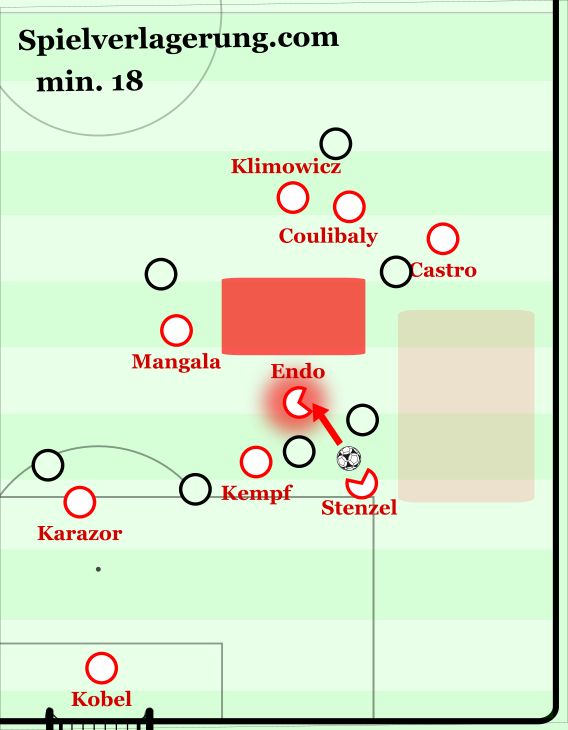
A second characteristic mechanism often applied in vertical play to pass opposition and create scoring opportunities refers to quick layoffs and one-touch passes. This mechanism was largely featured by vertical line-breaking passes, followed by one touch lay-offs or up, back, or throughs.
How and when such moves are executed is a rather open process depending upon the inventiveness of the players. Hence, Stuttgart applies this means in both deeper zones in build-up and higher zones in opportunity creation. While we saw an example in graph 4 for the former, graph 5 shows how Kalajdzic uses a layoff to bring Coulibaly in a promising situation in higher areas. Remarkably, this attack is no accident and product of one player having a brilliant moment. Instead the team collectively looks out for and prepares such plays. This build on the before mentioned mental preparedness and readiness of the players as collective structure, often allowing them to be one thought and step ahead of their opposition. There is a clear idea in own actions on how you play the next ball while not losing seconds in scanning options and considering where do play next. In the given situation, Kalajdzic is positioned so that the opposing defenders have to balance between coverage of deep space and marking Kalajdzic directly. Kempf plays a well-balanced pass in the ball-far foot of Kalajdzic. Coulibaly uses the pass by Kempf as trigger to start his run deep. Kalajdzic recognizes the opportunity supported by both the pass and the run to bring Coulibaly through a one-touch pass into position.
‘Pass and run’ is well-known in football as a very basic principle to attack: Once a pass has been played, a forward run to threaten the opposing defence would be made. After the initial pass, the follow-up run forward is made against the momentum of the defenders. Such dynamic movements on the blindside of individual defenders are harder to track, increasing the likelihood of an effective attack. Stuttgart extents the ‘pass and run’-principle to a group of players in moving an attack forward. Often, an opening, vertical pass triggers movements such as marginal corrections in
positioning or runs forward by one or two players not yet involved. Such collective ‘pass and run’-patterns are a weapon in the offensive play of the Swabs and applied more thoroughly in comparison to teams in Bundesliga.
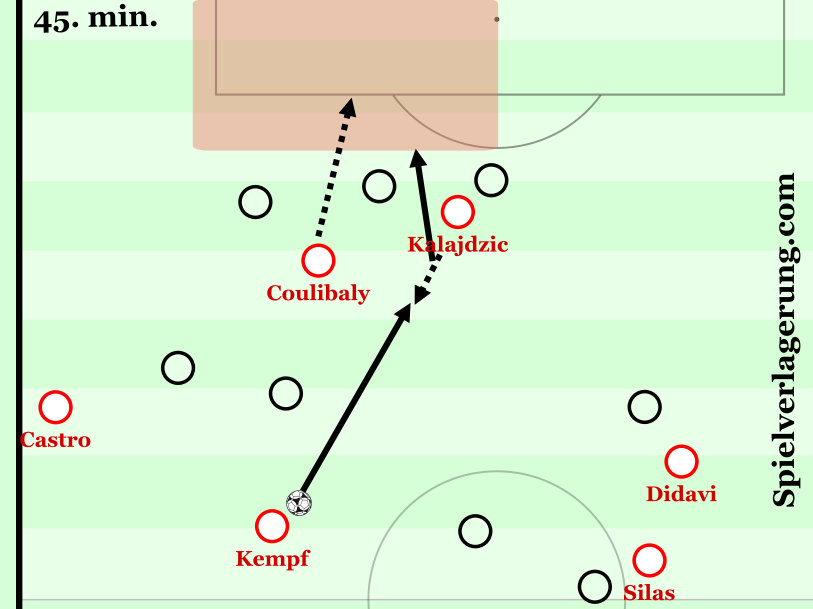
While the given situation in graph 5 demonstrates an example of a through-ball as final play before
the scoring opportunity arises, Stuttgart uses such quick layoffs and one-touch passes in multiple
situations and zones. Matarazzo wants his team to apply such simple yet effective plays in ball possession to create dynamic within seconds and increase the unpredictability of his team’s attacks. Rather than mainly relying on individual moments of ideas such as dynamic dribbles, he wants his team to apply such collective movement patterns. Graph 5, 6 and 7 show such effective plays Stuttgart uses to turn static situations into promising attacks. Especially the mechanism in graph 7 is applied in a wide array of situation and independent from specific players. In this exemplary situation, the participating players connect Karazor’s well-weighted pass in the narrow and overloaded central space with a short one-touch layoff by Klimowicz and a well-positioned Castro.
These simple mechanisms have helped the team to bypass several opposition players, bringing the team in a better position to continue the attack. The line-breaking pass to a player positioned at a focal point attracts the attention and often pressure from opponents. Such an opening pass is followed by a one touch lay-off in a direction against the moving momentum of the defenders, in opposite direction of the initial pass, or into the space vacated is applied as effective mechanism. Such collectively coordinated plays by Stuttgart are challenging to defend for opposition defenders, because they have to cope with their vision and body position. Furthermore, the role of the defenders changes within their zone with each touch and change of pace or direction, limiting time to react and adjust to the rapid changes of the situation.
The consistent observation of some movements and actions underlines that Stuttgart has clear pre-determined methods in place. This consistency of intention, the relative predictability of their own positioning within the structure, possibly better allows the players to collectively attune and respond to the changing demands of a situation. For this reason, one can observe attacks that have a similar intention, but different process to execute.
While this pattern may look simple and rather negligible, it is key to how the VfB strives to drive attacks in their centre-focused and dynamic style. Despite the simplicity, one should be aware of the difficulty to apply such mechanisms as all three, or more, parts of the puzzle need to align and work out in exact the right moment.
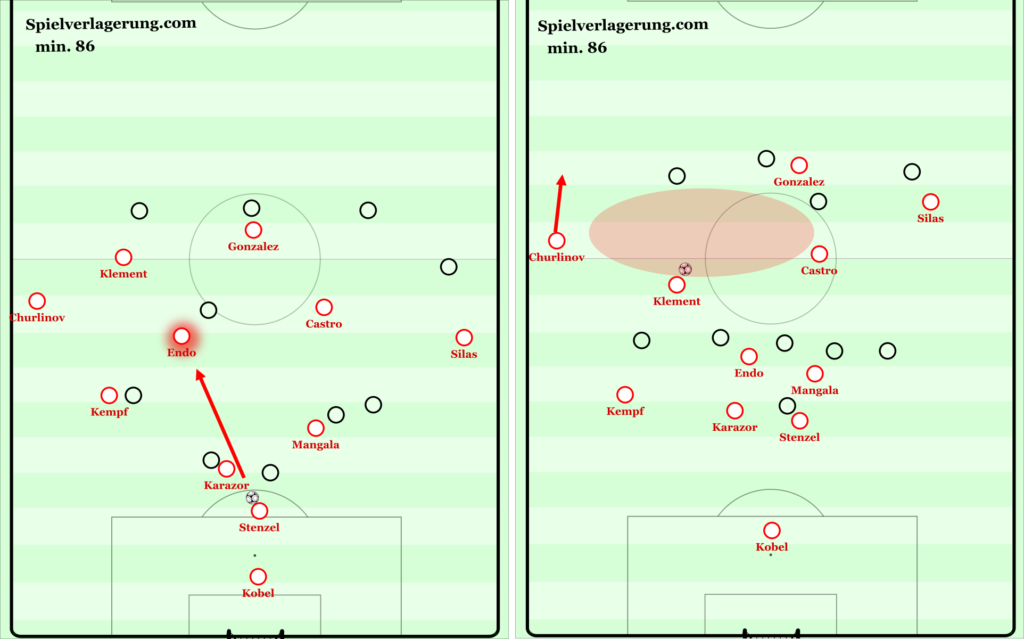
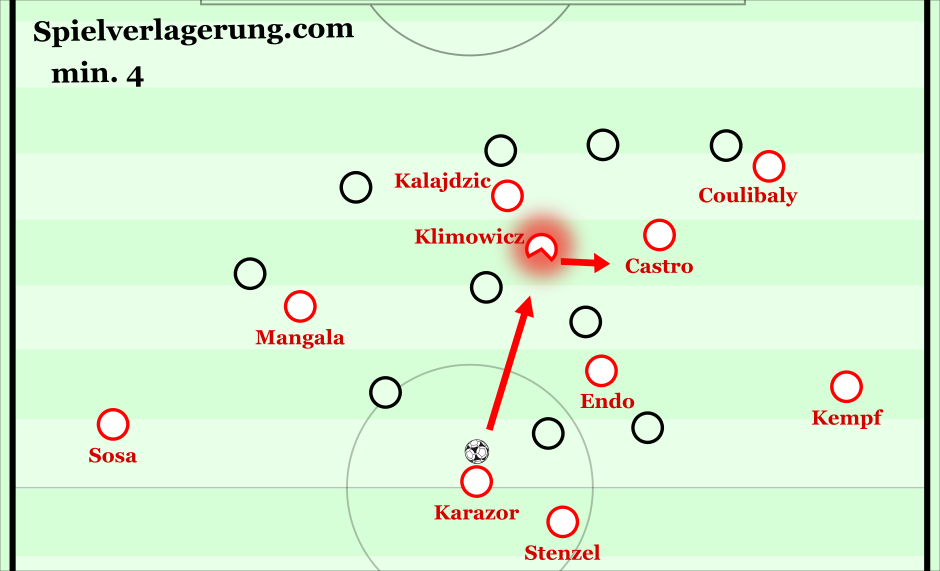
Graph 8 serves as last example that reflects Stuttgart’s general idea in ball position and the ability to pick up pace. The graph also emphasizes two general structural characteristics: first, players occupying different horizontal and vertical lines, and second, Endo in close supporting connection to the central defender in ball possession – providing a possible option in case of opponent pressure and an option to carry the ball to higher zones.
Considering the wide array of collective mechanisms to play vertically, it comes not surprising that Stuttgart moves the ball 32.72 meters (ranked 5th in Bundesliga in this statistic) during a phase of possession. Overall, Stuttgart does not create dominance through mere possession but through effective structures, allowing to pick up pace and a strong level of intensity.

A point for further improvement in ball possession for Matarazzo and his squad is the efficacy in scoring opportunities. This aspect often makes the difference between collecting 3, 1 and 0 points. Improving this dimension requires much detail work and is only worth spending valuable training time for if the team is able to create scoring opportunities in the first place. Stuttgart fulfills this prerequisite. Hence, Matarazzo can (luckily) get to work on the tricky part of increasing scoring efficiency. The way for the VfB to do so points towards improving the position from and circumstances under which to shoot. Graph 9 shows the expected likelihood of scoring for each of their taken shots. The graph encompasses many rather bright-colored (yellow) dots, indicating the unfavorable positions and game situation in which many shots were taken. Following this line of thinking, Stuttgart needs to find ways to get in more favorable positions for scoring, i.e. positions with higher xG-values. Since three of the top 12 shot takers on a per 90 are VfB players, with Nico Gonzalez leading the way, and rotation pieces/spot starters Klimowicz and Kalajdzic being the other two. Their top scorer Silas is 48th in that ranking, despite him and Kalajdzic being the best at outperforming their xG. What’s more troubling is that the aforementioned Gonzalez – Klimowicz duo which takes the most shots, is underperforming their xG by 4 goals!
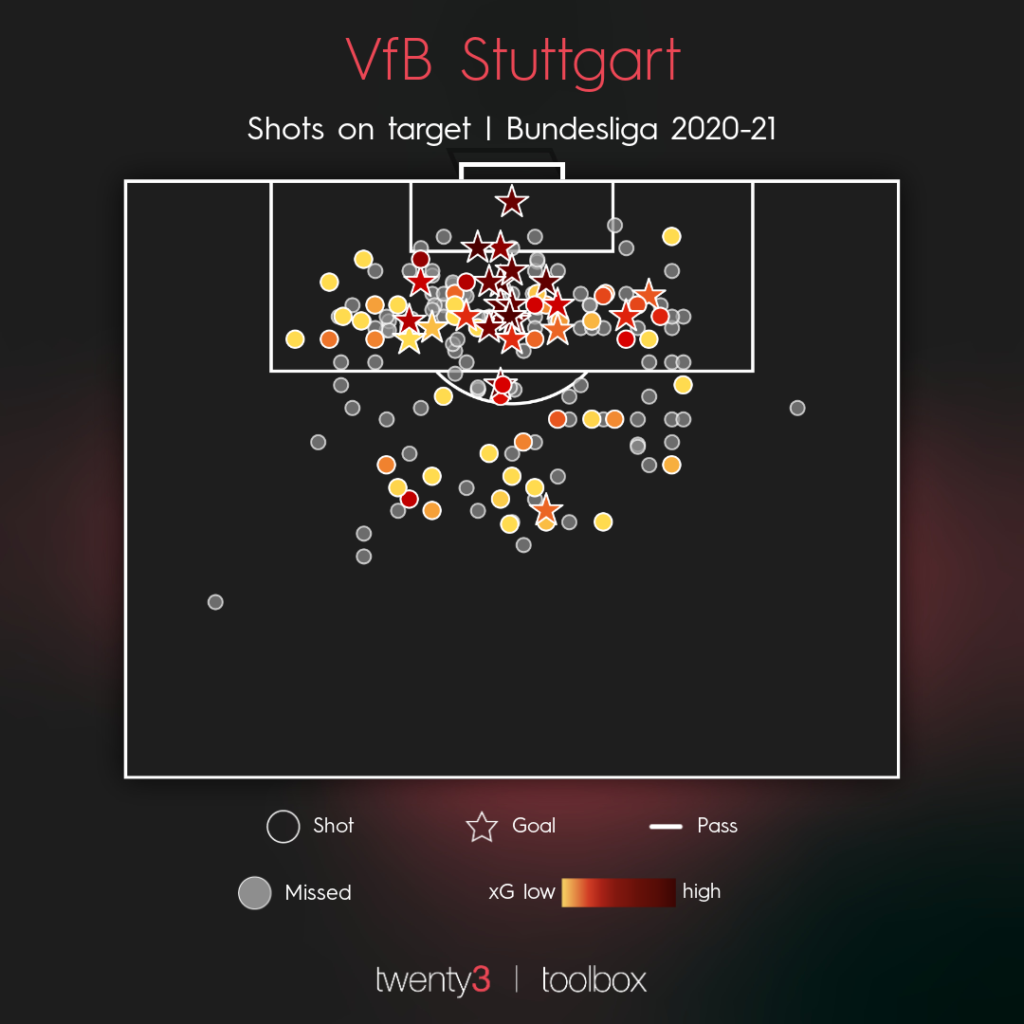
Play against the ball – the role of pressing and counter-pressing
At first look, Stuttgart seems to be a team that is said to be good in pressing. However, the game phase when Stuttgart faces an opponent in ball possession is not a focus area. Part of the reason is Matarazzo’s playing idea. The other part of the truth lays in the history of the coaches’ time as VfB head coach. For a better half of his tenure, back in the Second Bundesliga, Stuttgart faced defence-focused opponents, challenging Stuttgart to create scoring opportunities while covering against counter attacks. Therefore, the focus on the play in ball possession and transitions after ball losses was almost forced to take on. This challenge also fit in line with Matarazzo’s general ideas on football.
After the promotion, the quality of opponents and hence the demands on Stuttgart’s own level of play have arguably changed. More opponents are able and are willing to take a more active role in ball possession. Matarazzo has increasingly integrated aspects of more thorough mechanisms to how and when press the opponent in their ball possession without shifting the focus too much from their key strengths – play in ball possession and offensive transitions.
In general, the play against the ball still remains a game phase of no strategic importance. The pressing or phase when opponents have the ball is not unimportant, but rather not focused as much as the others. Nonetheless, the pressing up front occurs on a solid level. With two or three players attacking up front with potential support from the wingers, the central axis, Endo and Mangala, are positioned rather deep in closer connection to the defensive line. They are alert to push up quickly in remarkable pace to step in once the first line is outplayed. Mangala and Endo occupy such critical roles in the coverage of the first pressing line. As mentioned, covering their own attacks and preparing counter-pressing moments is a central concept, repeatedly thematised by Matarazzo. Thus, Endo and Mangala are conservative in pushing up into higher zones. In terms of output, Endo has more than double the number of pressures, per fbref.com, than that of Mangala. In fact, you will see at least always one of them positionally connected to the defensive line, because of their clearly assigned roles. Having said that, Stuttgart focuses to apply a solid play against the ball during a first phase, pressing up high whenever possible, and quickly tries to protect the own goal once the first pressing line is outplayed in the second phase.
In the previous article back in June 2020, I underlined the potential to apply situational pressing traps. On the one hand, there were many situations in which such traps could be set. The effectiveness to set pressing traps largely depends on own line-ups and opponent’s quality in escaping pressure and player’s pressing resistance. On the other hand, such an element could extent the unpredictability of Stuttgart even more and fit to Matarazzo’s favoured style. Indeed, Stuttgart started to set pressing traps occasionally in the course of the season. First, against Union Berlin the team successfully won ball possession this way. A second example occurred against Borussia Dortmund (graph 8). You can find more detailed description in the captions below the graph.
Overall, the Matarazzo team succeeded through well-coordinated collective movements and mental preparation for the plays – similar to Stuttgart’s collective mechanisms in build-up.

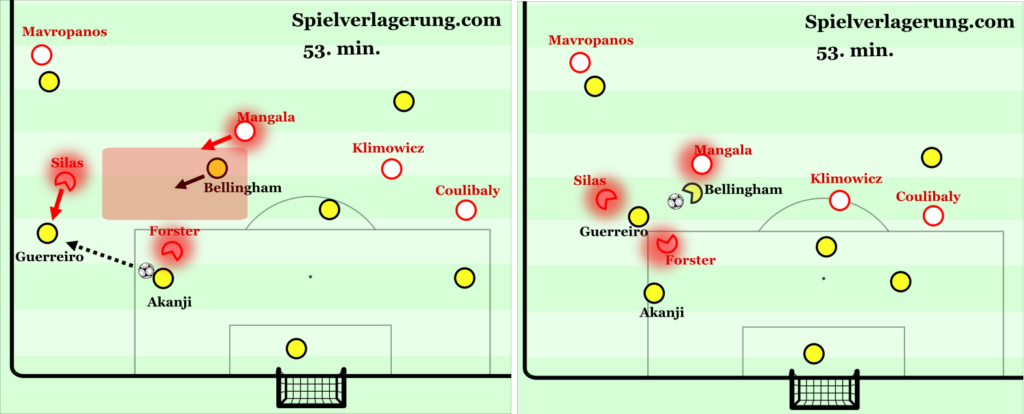
Despite the positive moments against the ball depicted above, Stuttgart is probably not that excited whenever the opponent has the ball. At least, this phase of the game remains as largest source of errors that led to scoring chances and goals against. Such errors can appear in multiple ways. This article includes two examples to indicate general issues Stuttgart has in this game phase.
First, Stuttgart is inconsistent in pressuring the opponent in general and ball carrier specifically once moved high up the pitch. Let’s consider some generalities before looking at the specific examples. The right moment when to pressure is often hard in higher zones, because one or a few players have to start action with consequent demands on the team mates in order to align with the pressing attempt. In turn, in a situation when the opponent starts the attack close to the centre line with all of their own players still behind the ball, the pressing is simpler due to being able to defend a narrower space. However, in such situations it might be hard to find the right moment to press, because the players up front do not realize the necessity, due to a perceived defensive stable situation. Unfortunately, this is often an error in perception and thinking. In fact, in such moments — as in graphs 10 and 11 — it is always wise to attack the ball carrier. One reason is that there are only disadvantages without any clear advantages if this ball carrier is allowed more time and space to consider his next action. If you attack with that many players behind the ball, the space is already narrow, and the cover shadow of the pressing players helps limit passing options. In turn, if the team in defense does not approach the opposition ball carrier, he has more options to play a long ball behind the defense line or for a vertical/ diagonal through ball. In addition, closer positioned to the ball increases the opponent’s opportunities and potential outcome of counter-pressing, and increases the distance to the opponent goal, reducing the likelihood of scoring through counter attacks.
In the exemplary situation against Eintracht Frankfurt (graph 12), the opposition ball carrier has wide space to move towards the VfB goal without pressure. Admittedly, Frankfurt shows clever positioning to keep the midfield line, Endo and Mangala, from moving forward. High and positioned between the lines (three Frankfurt players in shadowed area) results in both Klimowicz and Mangala hesitating from pressing whilst the pass is travelling onto the left wing. In this situation Mangala clearly has to pressure the ball carrier to limit his options.
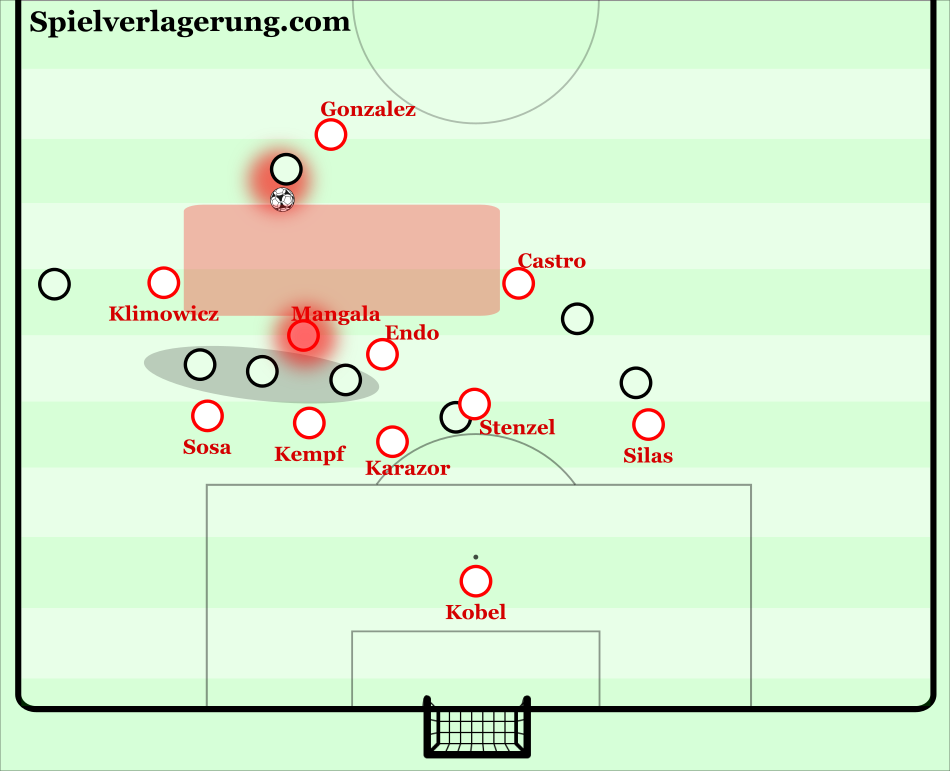
Second, Frankfurt misses the opportunity to pressure the opponent to eliminate options to continue play. In this example, Stuttgart reveals its inconsistent behavior not just in pressing but also in eliminating such options for opponents when moved up in their own half of the pitch. The effective occupation of spaces and usage of cover shadows belong to the tools Stuttgart could apply more effectively in such situations. In the recent game against RB Leipzig this inconsistency became obvious once more. After Leipzig had moved the ball horizontally from left to right to left, Stuttgart observes the plays too passively. It is one thing to deliberately wait for the right moment to attack as seen in the pressing trap situations. It is another to remain passive and have no clear idea how and when to win the ball. The situation in graph 13 is an example of the latter. The situation does not feel dangerous to the VfB players and hence pressing is rather neglected. Vertical shifting is not applied thoroughly. Hence, Castro misses the horizontal shift to cover the vertical pass lane for Upamecano. After the vertical pass, Leipzig can exploit the space and pick up pace.
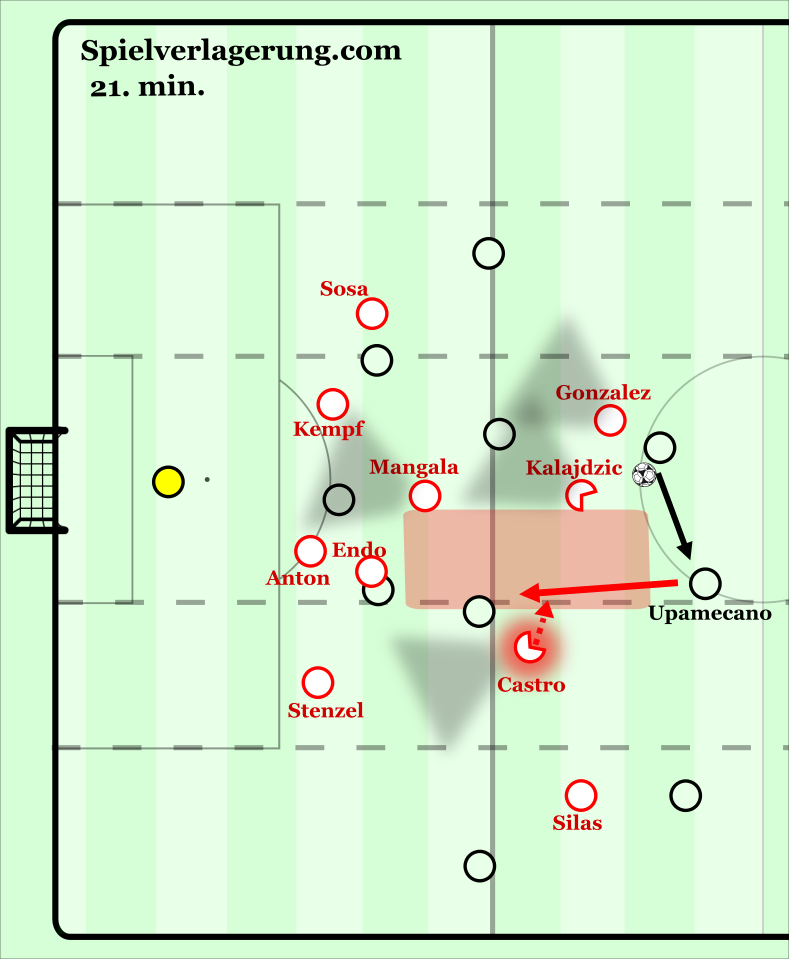
A third aspect to mention about Stuttgart’s defense is its vulnerability on the wings especially behind the more offensive right winger, a role often assumed by Silas. Positioned higher up the field and involved in offensive pressing right from the collective start of such action, the right half-defender, Stenzel or Mavropanos, have to occupy higher zones and the back-three have to shift to the right (see tilted formation in graph 1). Against Dortmund a collective pressing with the players on the right side involved was well applied (graph 11). Nonetheless, this does not mean that there is no disadvantage that needs to be accounted for in such patterns.
As mentioned above, Stuttgart has a unique structure including the role of the left and right winger. Especially Silas’ function within the team has shifted towards the role of an offensive winger or even forward, which has allowed him to score several goals and finish some sweeping attacks. Due to Silas’s designated positioning — but also in relation to his occasional neglectfulness to support defence once outplayed — opponents have started to exploit the space on the right wing. In a situation against VfL Wolfsburg, the right wings happened to be completely open. While the ball carrier was able — again without pressure and with much time in Stuttgart’s half — to move forward the space on the left was open to be exploited through a deep, diagonal run. On the one side, Stuttgart often manages to balance Silas’s offensive role by Silas’ own disciplined supporting runs backward, Stenzel’s well-timed movements forward from the RV position, or shifting in midfield (Mangala, Endo).
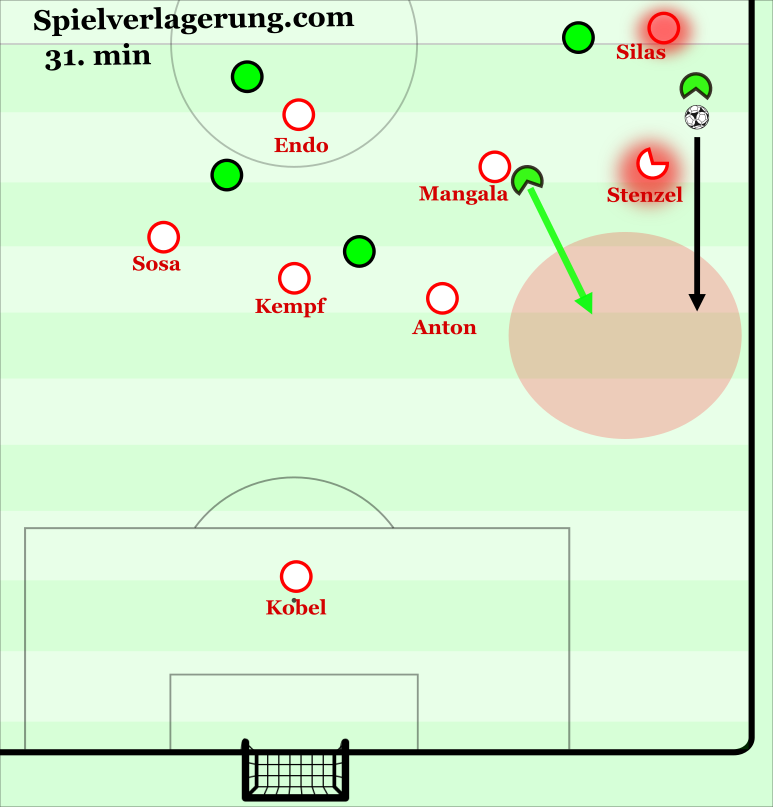
One the other side, when such mechanisms are not intact, opponents find more space on the wings that they are normally used to in the Bundesliga.
Concluding
VfB Stuttgart is on the right journey, securing ninth place after the first part of the season. Equally impressive is the way they are so successful. Their attractive and dynamical playing style is refreshing to the league.
At first look, Stuttgart seems to be a team that good in pressing. However, the team does create the intensity typical for their playing style not through mere pressing but rather counter pressing and even in build-up. The clear strengths remain is creation of flexible and effective structures across the pitch. This serves as foundation for their strong play in ball possession. This also allows for their strong counter pressing after offensive transitions i.e. ball losses. The pressing or phase when opponents have the ball is not unimportant, but rather not focused as much as the other phases of the game.
VfB certainly performed above their expectations during the first half of the season, yet more impressive is the array of strategies and structures they employed through build-up to ensure they consistently managed to penetrate and create against almost every opponent. Matarazzo has established a formidable attacking team that has the potential to beat every opponent. It will be intriguing whether the team and young players can keep performing in the Rückrunde and even make next steps in the development. It seems that this will hinge upon retaining their attacking potency, structures favourable for counter-pressing and whether Stuttgart can continue to adapt in the face of increasingly adapting and prepared opponents. Nonetheless, it will be interesting to observe it unfolding and following the Swabs to see how they proceed in this season’s endeavours.
Writing by Tobias Meyer; Editing by Abel Meszaros.
[ad_2]
Source link
